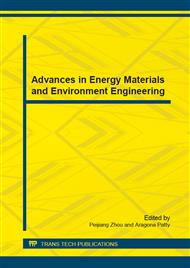p.148
p.152
p.156
p.161
p.170
p.175
p.181
p.185
p.189
Improved Power Performance of Activated Carbon Anode by Fe2O3 Addition in Microbial Fuel Cells
Abstract:
Poor energy output and high cost are the key factors to inhibit the development and application of microbial fuel cells (MFCs). Different types of modification techniques for anode material are suggested to improve power performance in MFCs. nanoFe2O3 is characteristics of no toxicity, biocompatibility and low cost. In this work, stainless steel mesh (SSM), ultracapacitor activated carbon with SSM (AcM), Fe2O3 added AcM (AMF) anodes are investigated to improve MFCs performance. The highest maximum power density (806 ± 26 mW·m-2) is obtained in AMF anode, which is 11 % higher than that of AcM (730 ± 27 mW·m-2), and 57 folds higher than that of SSM anode (12 ± 0.7 mW·m-2). The semi-conducting properties of passive film on the anode surface play a rather important role in anodic reaction by Mott-Schottky analysis. Tafel test demonstrates that the exchange current density (8.36×10-4 A·m-2) is improved by 20 % for AMF compared with AcM control (6.93×10-4 A·m-2). These results show AcM is suitable as MFCs anode, and further addition of Fe2O3 can increase the extracellular electron transfer in that way increase power production in MFCs.
Info:
Periodical:
Pages:
170-174
Citation:
Online since:
December 2014
Authors:
Price:
Сopyright:
© 2015 Trans Tech Publications Ltd. All Rights Reserved
Share:
Citation:


